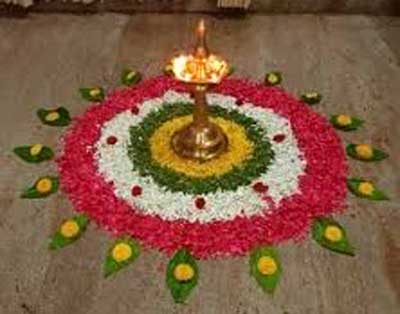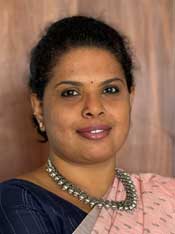A whole new world of kolam to welcome the Hindu New Year
 Kolam, the brilliantly colourful patterns that adorn Hindu thresholds come Puthandu (as the Tamils call their traditional new year) are a vital a part of the season like the payasam, the pachadi, the peal of kovil bells, the dousing cold bath by the well, and the pooja…
Kolam, the brilliantly colourful patterns that adorn Hindu thresholds come Puthandu (as the Tamils call their traditional new year) are a vital a part of the season like the payasam, the pachadi, the peal of kovil bells, the dousing cold bath by the well, and the pooja…In days of yore, kolam were really a part of everyday life, the lady of the house drawing them with white rice flour every dawn as the first rays of sunlight gently touched the earth. Through the day, they got worn with feet and next morning would be redrawn.
Today however, kolam connote festivities, and are very elaborate and vibrant, having also moved from the traditional ingredients of rice flour to include beads and flowers, as Gayathri Suveendran, Managing Director of Shaswathm, an event management company specialising in cultural activities, will tell you.
The pristine form of kolam, as drawn by the matriarch, was all white and ascetic-looking. First the ground was daubed with cow dung and water was sprinkled on it (to purify the ground) and then a grid pattern of dots was drawn. On this was the white rice flour pattern created.

Gayathri Suveendran
It was the department of the womenfolk, and girls were taught the art from age six. It trained girls to be a good housekeepers but also had physical, philosophical and spiritual aims. Physically, the woman has to bend at the waist and knees, stretching her hands, legs and upper torso out to draw the kolam. This stretches her muscles and joints. Philosophically, the bending of the body symbolises humility. Spiritually, the artist has to silently concentrate on her creation, as if meditating. The drawing also encourages creativity.
Kolam as we know it is a South Indian art, says Gayathri, and it was an invitation to nature. This was the primary purpose and not decoration. The ants could come and eat the rice flour, and so would birds and other small creatures. The patterns are geometrical and can have straight lines, curves and loops. It was believed that the pattern welcomed prosperity and wealth to the house along with the creatures who partook of the flour.
Traditional material like white stone powder and chalk powder were also used.
Evil spirits were driven out and Lakshmi, the goddess of prosperity was invited to the house with kolam and often a statue of Ganesh was kept in the middle. Symmetry was important as kolam denoted universal balance or the Hindu aspect of Shiva-Shakti.
Later, the decorative aspect of kolam came to the fore and colour seeped in. “What we call rangoli thus came to being,” says Gayathri.
Rangoli are the intricate curvaceous floral or similar patterns decked in colour. The basic shape is drawn and a variety of modern ingredients dyed with colour can go to fill the shapes – flowers, beads, scraped coconut, synthetic coloured powders or even, today, paper on rigifoam, or plastic.

Kolam: Colourful patterns that will soon adorn many homes
Fish, bird and animal images were used to symbolise the unity of man and beast. Sun, moon, stars and the zodiac signs were also used. A woman was depicted by a triangle pointing downwards and an upward pointing triangle a man. A circle represented nature while a square represented culture. A lotus represented the womb. A pentagram represented Venus and the five elements.
Today Hindu functions, whether a wedding, Pongal, birthday, housewarming or even gender reveal, come with cheery Kolam designs on the floor. Of course, for the approaching Hindu New Year, households will all display kolam with pride and joy.
Searching for an ideal partner? Find your soul mate on Hitad.lk, Sri Lanka's favourite marriage proposals page. With Hitad.lk matrimonial advertisements you have access to thousands of ads from potential suitors who are looking for someone just like you.


